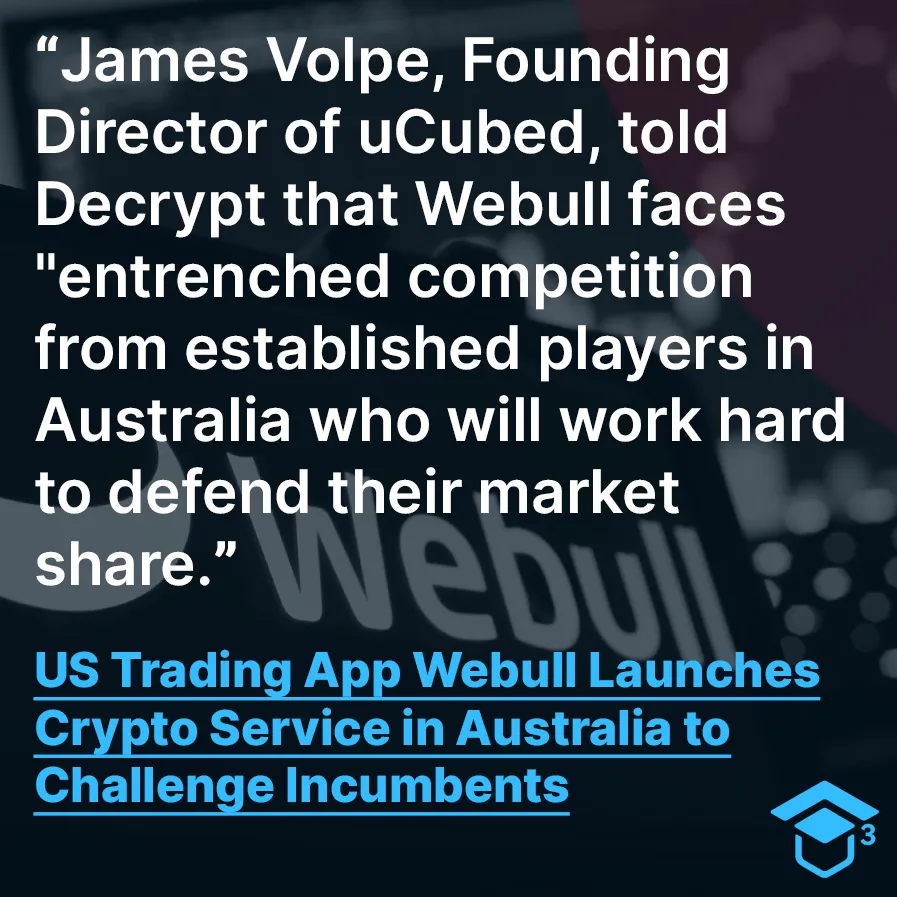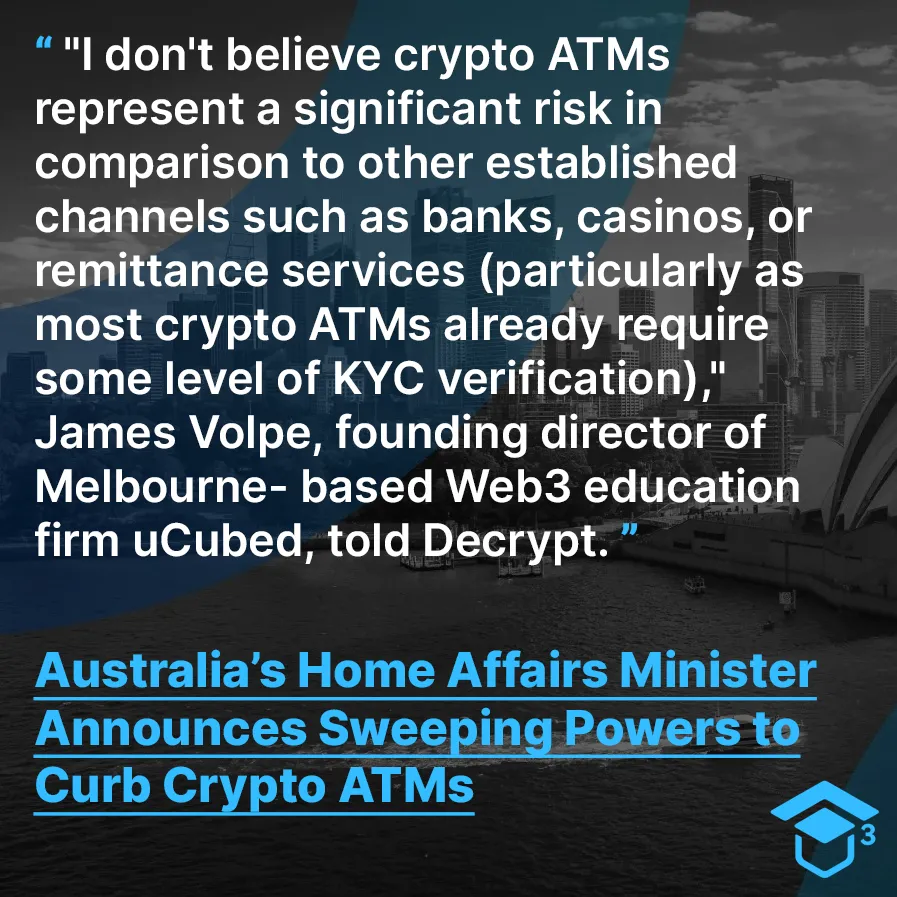uCubed is the bridge for informed and safe Blockchain, Digital Assets & Web3 experiences.

Business Training
Train your team for well-informed, planned, and successful innovating.

Personal Education
Educate yourself to become safe, secure, and smart.
ucubed equips individuals and teams with the knowledge & tools to safely thrive
Blockchain, Digital Assets & Web3 Education for Organisations & Individuals.
For Organisations
Efficient & complete understanding of the new landscape and how it works.
Discover and understand opportunities from a specialised lens.
Professional guidance that enables smooth and practical integrations.
Quickly take your team from behind the curve, to ahead of the curve.
Take advantage of new technology to enhance and expand client offerings.


For Individuals
Get qualified for higher paying, non-technical roles in Web3.
Become educated in a new and prosperous technological landscape.
Avoid scams, hacks, deceit, preventable losses and technical mistakes.
Conduct smarter and more efficient digital asset research.
Gain verifiable credentials that prove your knowledge to employers.
stay ahead of the curve
The uCubed Newsletter
uCubed newsletter subscribers receive the latest updates about:
Industry Shifts & Major Blockchain Adoption Events.
Digital Asset Market Commentary, News & Updates.
Web3 Job Market Data & Emerging Career Opportunities.
uCubed Company Growth and Development Updates.
Get answers to the most common questions about blockchain & web3 topics
Frequently Asked Questions
How does Blockchain technology work?
Blockchain works as a decentralised digital ledger that records transactions across a network of computers, ensuring transparency and security without relying on a central authority. Each transaction is grouped into a “block” which is then cryptographically linked to the previous one, forming a chronological “chain.” Once added, these blocks can’t be altered without consensus from the network, making the system highly resistant to tampering or fraud. This structure enables trust between participants and serves as the foundation for cryptocurrencies, smart contracts, and many Web3 applications.
Blockchain takes database infrastructure, data sharing, and information liquidity to a level never seen before. Blockchain technology comes in multiple forms, most popularly, public blockchains (such as the Bitcoin blockchain and the Ethereum blockchain, as well as hundreds of others), as well as consortium blockchains and private blockchains, which provided hundred of value-adding opportunities for business, enterprise, and organisation use-cases.
What does Web3 mean?
Web3 (or Web 3.0) is the next evolution of the internet that uses blockchain technology to create a decentralised, user-owned digital ecosystem. Unlike today’s Web 2.0 where large corporations control data and platforms Web3 allows individuals to directly own digital assets, control their data, and participate in governance through decentralised applications (dApps) and tokens, enabling a more transparent, secure, and community-driven online experience.
What is Decentralisation?
Decentralisation is the shift from traditional, centralised systems (like banks, corporations, or databases controlled by one authority) to networks where control and data are distributed among many participants. In the context of blockchain, Web3, digital assets, and tokenisation, decentralisation replaces the need for a single database or middleman with a shared, tamper-resistant ledger that the public (or permissioned entities) can access and verify.
This new model transforms how information, value, and ownership are exchanged online. Instead of trusting a single organisation to store or approve data, decentralised systems rely on transparent code, consensus mechanisms, and cryptographic security, creating a new frontier for how the internet manages and transfers data, assets, and trust.
What is a Smart Contract?
A smart contract is a self-executing program stored on a blockchain that automatically enforces the terms of an agreement when predefined conditions are met. Unlike traditional contracts that rely on intermediaries like lawyers or banks, smart contracts use code to handle transactions directly between parties, ensuring trust, transparency, and efficiency.
Once deployed, the contract operates autonomously, executing actions such as transferring funds, issuing tokens, or verifying ownership (without human intervention). Because all actions are recorded on the blockchain, smart contracts are tamper-proof and verifiable, making them the foundation for many decentralised applications (dApps) and services in the Web3 and DeFi ecosystems.
What is a Cryptocurrency?
A cryptocurrency is a native digital asset that exists directly on a blockchain, meaning it isn’t created or added to the network later like a token, it is integral to the blockchain’s core protocol. Cryptocurrencies serve as the economic layer of their respective blockchains, providing the incentive mechanism that secures and sustains decentralised networks. Examples include Bitcoin (BTC) on the Bitcoin blockchain and Ether (ETH) on Ethereum.
In the broader digital asset ecosystem, cryptocurrencies represent the foundational form of value exchange, enabling peer-to-peer transactions, rewarding network participation, and acting as the native currency for on-chain operations such as transaction fees, staking, or governance.
What is a Stablecoin?
A stablecoin is a type of cryptocurrency designed to maintain a stable value by being pegged to a reserve asset, such as a fiat currency like the U.S. dollar, a commodity like gold, or a basket of assets. Unlike cryptocurrencies that tend to be volatile (such as Bitcoin, Ethereum, Solana, and others), stablecoins use mechanisms to keep their price consistent, either by holding actual reserves (fiat-backed), using crypto collateral (crypto-backed), or employing algorithms that adjust supply and demand (algorithmic).
When demand increases, new coins may be issued; when it decreases, coins are removed from circulation. This stability makes stablecoins useful for payments, remittances, and trading within the blockchain ecosystem without exposure to extreme price fluctuations.
What is Tokenisation?
Tokenisation is the process of converting real-world assets such as money, property, stocks, or even art into digital tokens on a blockchain. Each token represents ownership or a share of the underlying asset and can be traded, transferred, or divided more easily than traditional forms of ownership.
This technology increases liquidity, reduces transaction costs, and enables fractional ownership, allowing more people to invest in assets that were previously difficult to access. In essence, tokenisation bridges the gap between physical and digital economies by turning real assets into secure, blockchain-based digital representations.
What are Digital Assets?
Digital assets are electronic forms of value or content that can be created, stored, and traded digitally, often using blockchain technology for security and verification. They include cryptocurrencies like Bitcoin and Ethereum, non-fungible tokens (NFTs) that represent ownership of unique digital items, and tokenised real-world assets such as stocks, real estate, or commodities.
Beyond blockchain, digital assets can also refer to data-driven resources like digital art, videos, or intellectual property stored online. What sets blockchain-based digital assets apart is their verifiable ownership, transferability, and transparency, enabling new forms of economic activity and investment in the digital economy.
Searching for more answers?

uCubed specialises education, training and consulting for Blockchain & Web3 technologies.
Level 24, 570 Bourke Street, Melbourne, VIC, 3000
1800 uCubed (1800 82 82 33)
Mon-Fri 9:00am-6:00pm AEDT
Legal
Stay ahead of the curve
Subscribe to receive the latest industry news, market commentary, web3 job data, and more.
uCubed (ABN # 49 679 988 204) is a business owned and operated by uCubed Co Pty Ltd (ACN # 679 988 204) © Copyright 2025. uCubed. All Rights Reserved.




